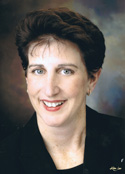The sacred text of Sh’ma- V’ahavta, repeated daily in our liturgy, inspires and guides us to teach and share – diligently – these words of Torah. Music is the perfect means of expression for joyously fulfilling this obligation. Through musical interpretation of the text, we are easily able to put these words in our mouths “when we are at home and when we are on our way.”
In their articles of the last few weeks, Rabbi Richard Sarason and Iris Koller have taught us about the differences in liturgical emphasis of the three paragraphs of the Sh’ma in building a communal and individual relationship with God. The English recitation of the first of the three paragraphs of the text of V’ahavta, became imprinted upon those of us who grew up in Reform congregations. With the development of contemporary Jewish music and participatory services has come a wider variety of settings for both the Hebrew and English texts.
The first musical example of this text that you will hear, is chanting to Torah trop, or cantillation. The Talmud tells us that “the Torah should be read in public, and made understood to its hearers in musical and sweet tones.”(Babylonian Talmud Megillah. 32a) Historically, thus, chanting the text became the way we were able to express its meaning and beauty, and it is inspirational for us to chant, as from the Torah, together as a community. Mishkan T’filah includes the cantillation marks so we may learn as a community while we chant as a community. Listen There are many examples which help to musically define the text as well as the changes in modern Jewish music which have occurred in the 20th and 21st centuries.
Ernest Bloch spent a year studying the synagogue music and Hebrew texts used for Shabbat morning worship as part of his preparations for composing a glorious version ofV’ahavta in 1933 for his choral work, “Avodath HaKodesh,” “Sacred Service.” The use of three part women’s voices created a then contemporary and beautiful contrast to the Cantor’s part, a baritone solo. Israeli composer Yehezkiel Braun who served as professor of music at Tel Aviv University had a particular interest in liturgical chant and Jewish folk music. The choral setting from his Evening Service for the Sabbath, also for baritone Cantor and choir, is a favorite of students from HUC’s School of Sacred Music. Unfortunately, I am not able to provide musical examples for these two pieces here – but they are worth looking up and taking some time to listen to them.
Michael Isaacson’s V'ahavta was composed at Kutz camp in 1967. It begins with a nigun, which at the time was a newer approach to prayer and communal singing, and it did not require fluency in Hebrew. The structure is strophic, meaning it includes a piece of text then returns to the nigun giving the worshipper the comfort of something musically familiar. Alternate measures offer a horafeeling, making the composition immediately familiar to a new listener. Interestingly, this composition was one of Isaacson’s very first attempts at synagogue composition and continues to be one of his most popular compositions. What was originally intended for campers on a casual, sunny, summer day, has gone mainstream as those of all ages have often labeled it "traditional." Listen
Debbie Friedman, as Cantor Ellen Sussman mentioned in her article about Sh’ma, was a pioneer in using the folk style in her compositions. In a recent conversation, Debbie explained that her work as a young song leader for her congregation and her participation in the song-leader workshop at Kutz Camp led to her 1971 setting of “V'ahavta,” “And Thou Shalt Love,” her very first composition. She composed the music first and chose the text later because, growing up, it was her very favorite prayer and she didn’t feel she could write lyrics. She taught it to a group of teens who were leading a creative service. Debbie recalled how they were so deeply moved to finally have a genre of Jewish music to which they could relate. Listen
Julie Silver shared with me a beautiful story of how she came to compose her version of this prayer. When she was in fourth grade, her Hebrew school class was assigned to learn V'ahavtaand each student was given one line of Hebrew. Because she didn't do her homework, she panicked when it was her turn to read. In that moment of panic, her Rabbi, Robert Miller said, "Don't worry, Julie. God hears all languages, including English." In 1993, as a devoted educator and Jewish songwriter Julie decided to write a setting honoring her beloved Rabbi, specifically geared toward the fourth grade students and of course, it had to be set it in English. Listen
There have been many settings to this text, from all facets of traditional and contemporary Jewish music. Musical interpretation gives us each of us the opportunity to find personal and communal inspiration and expression, and the ability to love God with all our heart, all our soul and all our strength.
Cantor Barbara R. Finn serves Congregation Albert in Albuquerque, New Mexico and is Chairperson of the Member Relations Committee of the American Conference of Cantors.

